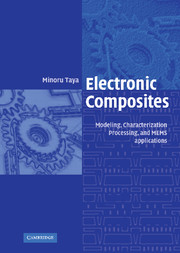Book contents
- Frontmatter
- Contents
- Preface
- Acknowledgements
- 1 Introduction
- 2 Applications of electronic composites
- 3 Foundations of modeling
- 4 Models for electronic composites based on effective medium theory
- 5 Resistor network model for electrical and thermal conduction problems
- 6 Percolation model
- 7 Lamination model
- 8 Engineering problems
- Appendix A Eshelby tensors
- Appendix B Physical constants and properties of materials
- References
- Author index
- Subject index
6 - Percolation model
Published online by Cambridge University Press: 03 May 2011
- Frontmatter
- Contents
- Preface
- Acknowledgements
- 1 Introduction
- 2 Applications of electronic composites
- 3 Foundations of modeling
- 4 Models for electronic composites based on effective medium theory
- 5 Resistor network model for electrical and thermal conduction problems
- 6 Percolation model
- 7 Lamination model
- 8 Engineering problems
- Appendix A Eshelby tensors
- Appendix B Physical constants and properties of materials
- References
- Author index
- Subject index
Summary
Percolation model based on base lattices
A percolation model was proposed first by Broadbent and Hammersley (1957). Since then, there have been a large number of studies of percolation problems, and two books (Stauffer and Aharony, 1991; Sahini, 1994). A percolation model (Shante and Kirkpatrick, 1971; Essam, 1972; 1980) is composed of two simple elements, a site and a bond, which are interconnected. In most cases there is a base lattice underlying sites and bonds. The key variable in percolation problems is the probability p of occupied bonds or sites. The probability that each bond or site is occupied or empty is entirely independent of whether its neighbors are occupied or empty. When p = 1, the model becomes exactly the same as the base lattice and none of the elements is empty.
There are two types of percolation problem. If the occupancy of bonds is governed by a stochastic mechanism, the problem is called a bond percolation problem, whereas if that of the sites is so governed, the problem is called a site percolation problem. Figures 6.1, 6.2, and 6.3 show examples of these problems. A two-dimensional (2D) square lattice is taken as a base lattice, as shown in Fig. 6.1. Figure 6.2 shows a bond percolation problem of this 2D base lattice, where the probability of bonds pb = 0.5. Figure 6.3 show a site percolation problem of the same base lattice, where the probability of sites ps = 0.5.
- Type
- Chapter
- Information
- Electronic CompositesModeling, Characterization, Processing, and MEMS Applications, pp. 173 - 207Publisher: Cambridge University PressPrint publication year: 2005



